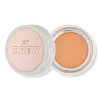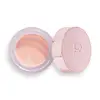Flower Beauty by Drew Chill Out Smoothing Color Corrector Versus Revolution Beauty Under Eye Corrector
What's inside
What's inside
 Key Ingredients
Key Ingredients

 Benefits
Benefits

 Concerns
Concerns

 Ingredients Side-by-side
Ingredients Side-by-side

Caprylic/Capric Triglyceride
MaskingOctyldodecanol
EmollientHdi/Trimethylol Hexyllactone Crosspolymer
Cellulose
AbsorbentMica
Cosmetic ColorantEuphorbia Cerifera Wax
Silica
AbrasiveCopernicia Cerifera Wax
Trimethylsiloxysilicate
EmollientAdipic Acid/Diglycol Crosspolymer
Bisabolol
MaskingDimethicone
EmollientButylene Glycol Cocoate
EmulsifyingNylon-12
C12-15 Alkyl Benzoate
AntimicrobialGlyceryl Behenate
EmollientC18-36 Acid Triglyceride
EmollientTribehenin
EmollientCI 77120
Cosmetic ColorantPhenoxyethanol
PreservativePolyglyceryl-3 Diisostearate
EmulsifyingTriethoxycaprylylsilane
Hydrogenated Polydecene
EmollientEthylhexylglycerin
Skin ConditioningTocopherol
AntioxidantPolyhydroxystearic Acid
EmulsifyingJojoba Esters
EmollientWater
Skin ConditioningCannabidiol - Synthetically Produced
AntioxidantQuillaja Saponaria Root Extract
MaskingCaprylic/Capric Triglyceride, Octyldodecanol, Hdi/Trimethylol Hexyllactone Crosspolymer, Cellulose, Mica, Euphorbia Cerifera Wax, Silica, Copernicia Cerifera Wax, Trimethylsiloxysilicate, Adipic Acid/Diglycol Crosspolymer, Bisabolol, Dimethicone, Butylene Glycol Cocoate, Nylon-12, C12-15 Alkyl Benzoate, Glyceryl Behenate, C18-36 Acid Triglyceride, Tribehenin, CI 77120, Phenoxyethanol, Polyglyceryl-3 Diisostearate, Triethoxycaprylylsilane, Hydrogenated Polydecene, Ethylhexylglycerin, Tocopherol, Polyhydroxystearic Acid, Jojoba Esters, Water, Cannabidiol - Synthetically Produced, Quillaja Saponaria Root Extract
Paraffinum Liquidum
EmollientPolyisobutene
Hydrogenated Polyisobutene
EmollientPentaerythrityl Tetraisostearate
EmollientHydrogenated Microcrystalline Wax
Emulsion StabilisingPolyglyceryl-3 Diisostearate
EmulsifyingBis-Diglyceryl Polyacyladipate-2
EmollientSilica
AbrasiveParaffin
PerfumingGlyceryl Stearate Se
EmulsifyingCera Microcristallina
Emulsion StabilisingPhenoxyethanol
PreservativeSimmondsia Chinensis Seed Oil
EmollientVitis Vinifera Seed Oil
EmollientTocopheryl Acetate
AntioxidantTocopherol
AntioxidantBHT
AntioxidantCI 77891
Cosmetic ColorantCI 77499
Cosmetic ColorantCI 77491
Cosmetic ColorantCI 77492
Cosmetic ColorantParaffinum Liquidum, Polyisobutene, Hydrogenated Polyisobutene, Pentaerythrityl Tetraisostearate, Hydrogenated Microcrystalline Wax, Polyglyceryl-3 Diisostearate, Bis-Diglyceryl Polyacyladipate-2, Silica, Paraffin, Glyceryl Stearate Se, Cera Microcristallina, Phenoxyethanol, Simmondsia Chinensis Seed Oil, Vitis Vinifera Seed Oil, Tocopheryl Acetate, Tocopherol, BHT, CI 77891, CI 77499, CI 77491, CI 77492
Ingredients Explained
These ingredients are found in both products.
Ingredients higher up in an ingredient list are typically present in a larger amount.
Phenoxyethanol is a preservative that has germicide, antimicrobial, and aromatic properties. Studies show that phenoxyethanol can prevent microbial growth. By itself, it has a scent that is similar to that of a rose.
It's often used in formulations along with Caprylyl Glycol to preserve the shelf life of products.
Polyglyceryl-3 Diisostearate is an emulsifer and emollient. It comes from Isostearic Acid and Polyglycerin-3.
As an emulsifier, it helps stabilize products by preventing oils and water from separating.
This ingredient may not be Malassezia folliculitis, or fungal acne safe.
Learn more about Polyglyceryl-3 DiisostearateSilica, also known as silicon dioxide, is a naturally occurring mineral. It is used as a fine, spherical, and porous powder in cosmetics.
Though it has exfoliant properties, the function of silica varies depending on the product.
The unique structure of silica enhances the spreadability and adds smoothness, making it a great texture enhancer.
It is also used as an active carrier, emulsifier, and mattifier due to its ability to absorb excess oil.
In some products, tiny microneedles called spicules are made from silica or hydrolyzed sponge. When you rub them in, they lightly polish away dead skin layers and enhance the penetration of active ingredients.
Learn more about SilicaTocopherol (also known as Vitamin E) is a common antioxidant used to help protect the skin from free-radicals and strengthen the skin barrier. It's also fat soluble - this means our skin is great at absorbing it.
Vitamin E also helps keep your natural skin lipids healthy. Your lipid skin barrier naturally consists of lipids, ceramides, and fatty acids. Vitamin E offers extra protection for your skin’s lipid barrier, keeping your skin healthy and nourished.
Another benefit is a bit of UV protection. Vitamin E helps reduce the damage caused by UVB rays. (It should not replace your sunscreen). Combining it with Vitamin C can decrease sunburned cells and hyperpigmentation after UV exposure.
You might have noticed Vitamin E + C often paired together. This is because it is great at stabilizing Vitamin C. Using the two together helps increase the effectiveness of both ingredients.
There are often claims that Vitamin E can reduce/prevent scarring, but these claims haven't been confirmed by scientific research.
Learn more about Tocopherol